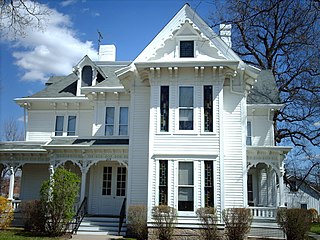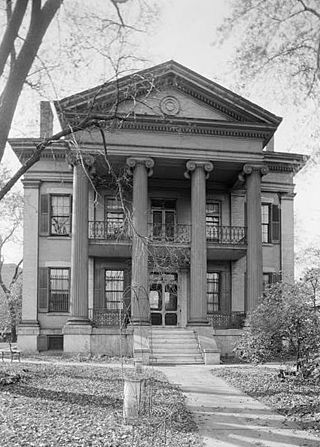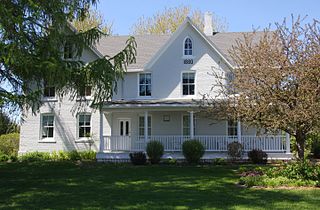
Butler is a city in Bates County, Missouri, United States and is part of the Kansas City metropolitan area. The population was 4,219 at the 2010 census. The county seat of Bates County, the city is named for William Orlando Butler, a noted American military and political figure of the early and mid-19th century. It is located approximately 50 mi (80 km) south of Kansas City, Missouri on U.S. Route 71-Interstate 49.

Gladstone is a city in Clay County, Missouri, United States and a suburb of Kansas City. The City of Gladstone is located about 10–20 minutes from downtown Kansas City, and about 10–20 minutes from Kansas City International Airport. As of the 2020 census, the city population was 27,063. It is part of the Kansas City metropolitan area.

Poplar Bluff is a city in Butler County in Southeast Missouri, United States. It is the county seat of Butler County and is known as "The Gateway to the Ozarks" among other names. The population was 16,225 at the 2020 census. The Poplar Bluff Micropolitan Statistical Area consists of all of Butler County. The city is at the crossroads of U.S. Route 60 and U.S. Route 67.

Independence is the 5th most populous city in Missouri and the county seat of Jackson County. Independence is a satellite city of Kansas City, Missouri, and is the largest suburb on the Missouri side of the Kansas City metropolitan area. In 2020, it had a total population of 123,011.

The Harry S. Truman National Historic Site preserves the longtime home of Harry S. Truman, the 33rd president of the United States, as well as other properties associated with him in the Kansas City, Missouri metropolitan area. The site is operated by the National Park Service, with its centerpieces being the Truman Home in Independence and the Truman Farm Home in Grandview. It also includes the Noland home of Truman's cousins, and the George and Frank Wallace homes of Bess Truman's brothers. The site was designated a National Historic Site on May 23, 1983.

Blackacre State Nature Preserve is a 271-acre (110 ha) nature preserve and historic homestead in Louisville, Kentucky. The preserve features rolling fields, streams, forests, and a homestead dating back to the 18th century. For visitors, the preserve features several farm animals including horses, goats, and cows, hiking trails, and a visitor's center in the 1844-built Presley Tyler home. Since 1981, it has been used by the Jefferson County Public Schools as the site of a continuing environmental education program. About 10,000 students visit the outdoor classroom each year.

Mid-Continent Public Library, officially known as Consolidated Library District #3, is a public library system serving Clay, Platte, and Jackson counties in Missouri, with headquarters in Independence, Missouri.

The Atlas Life Building is a historic twelve-story building in downtown Tulsa, Oklahoma. Designed by the firm Rush, Endacott and Rush, the building was completed in 1922. It is located at 415 S. Boston Avenue, sandwiched between the Philtower and Mid-Continent Tower. On May 19, 2009, it was added to the U.S. National Register of Historic Places. Originally an office building, it was converted to hotel use in 2010.

The Mayhew Cabin, in Nebraska City, Nebraska, is the only Underground Railroad site in Nebraska officially recognized by the National Park Service. It is included among the sites of the National Underground Railroad Network to Freedom.

The Asa Locke House is a historic house in Winchester, Massachusetts. Built in the mid-19th century, it is a well-preserved local example of a side-hall Italianate farmhouse. It is also notable for its association with the locally prominent Locke family, who settled the area in 1699. The house was listed on the National Register of Historic Places in 1989.

The Gale–Banks House is a historic house at 935 Main Street in Waltham, Massachusetts. This farmhouse was built c. 1798, and is one of the finest Federal style houses in the city. It is also significant for its association with Waltham native son, Governor of Massachusetts, and general of the American Civil War, Nathaniel Prentice Banks, who purchased it in 1855 and made it is home until his death in 1894. The house was listed on the National Register of Historic Places in 1990.

The Chatillon–DeMenil Mansion, located at 3352 DeMenil Place in Benton Park, St. Louis, Missouri, was begun in 1848 for the pioneer Henry Chatillon, then enlarged to its present form by prominent St. Louis businessman Nicolas DeMenil from 1855 to 1863. The house serves as a house museum, and according to its nomination to the National Register of Historic Places, described "as being the finest example of Greek Revival architecture in the Midwest."

The Cobblestone Farm and Museum, which includes the Dr. Benajah Ticknor House is an historical museum located at 2781 Packard Road in Ann Arbor Michigan. The museum gets its name from the cobblestone used to build the farmhouse. It was listed on the National Register of Historic Places in 1972 and designated a Michigan State Historic Site in 1973.

The Osmund Osmundson House is a historic house in Nerstrand, Minnesota, United States. The private home was placed on the National Register of Historic Places (NRHP) on April 6, 1982. The house is significant for its association with a prominent Rice County pioneer and town founder.

The Bonde Farmhouse is a historic farmhouse located in Wheeling Township in Rice County, Minnesota, United States, approximately 1 mile (1.6 km) from Nerstrand. The private home was placed on the National Register of Historic Places (NRHP) on April 6, 1982. The farmhouse is significant both for its association with a prominent Norwegian immigrant family as well as its local limestone construction and outstanding integrity.

The Buckminster-Kingsbury Farm is a historic farmhouse at 80 Houghton Ledge Road in Roxbury, New Hampshire. The brick house was built c. 1825, and is a well-preserved example of vernacular Federal and Greek Revival styling. The house was listed on the National Register of Historic Places in 2011.

The 1855 Harris-Kearney House is an historical site located in Kansas City, Missouri, in the Westport neighborhood. Originally, the house was located at the intersection of modern-day Westport Road and Main Street The home is the oldest brick residence in the city.
Big Hill Farmstead Historic District is a historic home and farm and national historic district located at Jackson, Cape Girardeau County, Missouri. The farmhouse was built about 1855, and is a two-story, five bay, brick I-house with Greek Revival and Italianate style design elements. It has a hipped roof and features a gallery porch. Other contributing elements are the a timber frame barn, a cabin/workshop, a wagon shed, and the surrounding farmland.

Elvis Presley House is a one-story ranch style house in a residential neighborhood in Memphis, Tennessee. Singer Elvis Presley lived here with his parents between March 1956 and March 1957, before moving to Graceland.
Emery Farm is a historic farm property at 16 Emery Lane in Stratham, New Hampshire. The farmhouse, built about 1740, is a fine example of period architecture, with later 19th century stylistic alterations. The property is notable as one of New Hampshire's first market garden farms, a practice adopted by John Emery in 1855. The property was listed on the National Register of Historic Places in 2017.
























